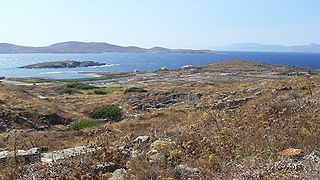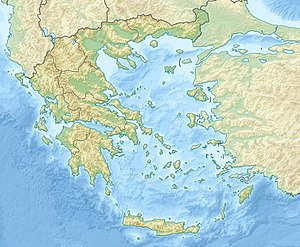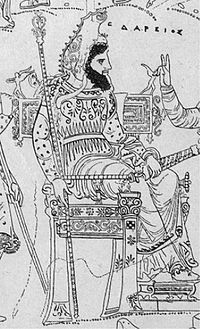
The Battle of Marathon took place in 490 BC during the first Persian invasion of Greece. It was fought between the citizens of Athens, aided by Plataea, and a Persian force commanded by Datis and Artaphernes. The battle was the culmination of the first attempt by Persia under King Darius I to subjugate Greece. The Greek army inflicted a crushing defeat on the more numerous Persians, marking a turning point in the Greco-Persian Wars.

Year 490 BC was a year of the pre-Julian Roman calendar. At the time, it was known as the Year of the Consulship of Camerinus and Flavus. The denomination 490 BC for this year has been used since the early medieval period, when the Anno Domini calendar era became the prevalent method in Europe for naming years.
This article concerns the period 499 BC – 490 BC.

The Battle of Salamis was a naval battle fought in 480 BC, between an alliance of Greek city-states under Themistocles, and the Achaemenid Empire under King Xerxes. It resulted in a victory for the outnumbered Greeks.

The Ionian Revolt, and associated revolts in Aeolis, Doris, Cyprus and Caria, were military rebellions by several Greek regions of Asia Minor against Persian rule, lasting from 499 BC to 493 BC. At the heart of the rebellion was the dissatisfaction of the Greek cities of Asia Minor with the tyrants appointed by Persia to rule them, along with the individual actions of two Milesian tyrants, Histiaeus and Aristagoras. The cities of Ionia had been conquered by Persia around 540 BC, and thereafter were ruled by native tyrants, nominated by the Persian satrap in Sardis. In 499 BC, the tyrant of Miletus, Aristagoras, launched a joint expedition with the Persian satrap Artaphernes to conquer Naxos, in an attempt to bolster his position. The mission was a debacle, and sensing his imminent removal as tyrant, Aristagoras chose to incite the whole of Ionia into rebellion against the Persian king Darius the Great.

The Greco-Persian Wars were a series of conflicts between the Achaemenid Empire and Greek city-states that started in 499 BC and lasted until 449 BC. The collision between the fractious political world of the Greeks and the enormous empire of the Persians began when Cyrus the Great conquered the Greek-inhabited region of Ionia in 547 BC. Struggling to control the independent-minded cities of Ionia, the Persians appointed tyrants to rule each of them. This would prove to be the source of much trouble for the Greeks and Persians alike.

The Battle of Lade was a naval battle which occurred during the Ionian Revolt, in 494 BC. It was fought between an alliance of the Ionian cities and the Persian Empire of Darius the Great, and resulted in a decisive victory for the Persians which all but ended the revolt.
Artaphernes, was influential circa 513–492 BC and was a brother of the Achaemenid king of Persia, Darius I. He was appointed satrap of Lydia from the capital of Sardis, and was a Persian general. In his position he had numerous contacts with the Greeks, and played an important role in both the Siege of Naxos and in suppressing the Ionian Revolt.

Histiaeus, the son of Lysagoras, was a Greek ruler of Miletus in the late 6th century BC. Histiaeus was tyrant of Miletus under Darius I, king of Persia, who had subjugated Miletus and the other Ionian states in Asia Minor, and who generally appointed Greeks as tyrants to rule the Greek cities of Ionia in his territory.

Datis or Datus was a Median noble and admiral who served the Persian Empire during the reign of Darius the Great. He was familiar with Greek affairs and maintained connections with Greek leaders. He is noted for his joint leadership with the younger Artaphernes of the Persian forces in the first campaign of the Persian Wars against the Greeks.

The Battle of Ephesus took place in 498 BC between Persian and Greek forces during the Ionian revolt. The Persians defeated the Greek army and compelled the Athenians and Eretrians to abandon their alliance with the Ionians.

Miltiades, also known as Miltiades the Younger, was a Greek Athenian statesman known mostly for his role in the Battle of Marathon, as well as for his downfall afterwards. He was the son of Cimon Coalemos, a renowned Olympic chariot-racer, and the father of Cimon, the noted Athenian statesman.

The siege of Naxos was a failed attempt by the Milesian tyrant Aristagoras, operating with support from, and in the name of the Persian Empire of Darius the Great, to conquer the island of Naxos. It was the opening act of the Greco-Persian Wars, which would ultimately last for 50 years.

The siege of Sardis was the first major engagement of the Ionian Revolt. An allied Greek army launched an attack on the Persian satrapal capital of Sardis but were ultimately repelled by Persian forces, however most of the city was set alight during the siege.

The Battle of the Eurymedon was a double battle, taking place both on water and land, between the Delian League of Athens and her Allies, and the Persian Empire of Xerxes I. It took place in either 469 or 466 BCE, in the vicinity of the mouth of the Eurymedon River in Pamphylia, Asia Minor. It forms part of the Wars of the Delian League, itself part of the larger Greco-Persian Wars.
Artaphernes, son of Artaphernes, was the nephew of Darius the Great, and a general of the Achaemenid Empire.

The first Persian invasion of Greece took place from 492 BC to 490 BC, as part of the Greco-Persian Wars. It ended with a decisive Athenian-led victory over the Achaemenid Empire during the Battle of Marathon. Consisting of two distinct campaigns, the invasion of the independent Greek city-states was ordered by the Persian king Darius the Great, who sought to punish Athens and Eretria after they had supported the earlier Ionian Revolt. Additionally, Darius also saw the subjugation of Greece as an opportunity to expand into Southeast Europe and thereby ensure the security of the Achaemenid Empire's western frontier.

The second Persian invasion of Greece occurred during the Greco-Persian Wars, as King Xerxes I of Persia sought to conquer all of Greece. The invasion was a direct, if delayed, response to the defeat of the first Persian invasion of Greece at the Battle of Marathon, which ended Darius I's attempts to subjugate Greece. After Darius's death, his son Xerxes spent several years planning for the second invasion, mustering an enormous army and navy. The Athenians and Spartans led the Greek resistance. About a tenth of the Greek city-states joined the 'Allied' effort; most remained neutral or submitted to Xerxes.

The Wars of the Delian League were a series of campaigns fought between the Delian League of Athens and her allies, and the Achaemenid Empire of Persia. These conflicts represent a continuation of the Greco-Persian Wars, after the Ionian Revolt and the first and second Persian invasions of Greece.
Cissia(Ancient Greek: Κισσία, Kissia) was a very fertile district of Susiana in the Persian Empire, on the Choaspes. According to Herodotus, the inhabitants, Cissii, were a 'wild', free people, resembling the Persians in their manners.




















